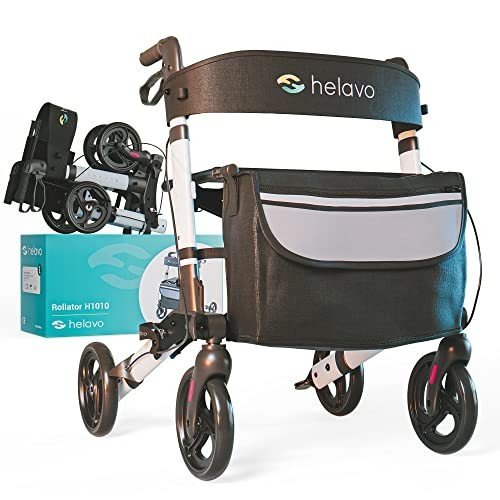See What Rollator For Walking Tricks The Celebs Are Using
페이지 정보
작성자 Madeline 댓글 0건 조회 277회 작성일 25-06-10 06:43본문
Understanding Rollators for Walking: A Comprehensive Guide
Rollators are an indispensable mobility aid that improves the liberty and self-reliance of those with minimal walking capabilities. They are created not just to use stability and support however also to motivate mobility and engagement in daily activities for people of all ages. This short article digs deep into the world of rollators, providing insights into their functions, benefits, types, maintenance, and key considerations when choosing the most suitable design.
What is a Rollator?
A rollator is a mobile walking aid equipped with four wheels, handgrips, a seat, and typically includes extra features such as storage baskets and brakes. Unlike standard walkers, which need the user to raise them off the ground, rollators can be pressed along as the user strolls, making them especially useful for people with minimal strength or balance.
Key Features of Rollators
Rollators consist of a number of functions that enhance their usability:
- Wheels: Most rollators feature swivel or fixed wheels for better maneuverability inside your home and outdoors.
- Brakes: Hand brakes enable users to manage their speed and stop securely.
- Seat: Many rollators provide an integrated seat for users to rest when required.
- Lightweight Frame: Constructed from lightweight materials, rollators are easy to raise and transport.
- Adjustable Height: Most rollators permit height changes to accommodate the user's stature.
Benefits of Using a Rollator
Utilizing a rollator uses various advantages, especially for seniors and individuals with mobility difficulties. These might consist of:

- Improved Stability: Rollators provide a steady base that assists prevent falls.
- Increased Mobility: Users can move about more easily, whether inside or outdoors.
- Boosted Independence: With a rollator, users can perform everyday tasks without requiring assistance.
- Practical Seating: The accessibility of a seat enables users to rest whenever they feel tired.
Types of Rollators
When considering which rollator to select, it's important to acknowledge the various types readily available. The primary categories include:
- Standard Rollators: Typically have 4 wheels and a seat, appropriate for the majority of indoor and outdoor environments.
- Sturdy Rollators: Designed for larger individuals, these rollators have actually enhanced frames and higher weight capabilities.
- Three-Wheel Rollators: These provide a more lightweight and compact alternative, making them perfect for narrower areas.
- Foldable Rollators: Convenient for transport, these designs can be easily collapsed and kept when not in use.
| Type of Rollator | Description | Best For |
|---|---|---|
| Requirement Rollator For Walking | Four wheels, seat, many choices. | General use, indoor and outdoor. |
| Sturdy Rollator | Strengthened for higher weight capability. | Bigger people requiring additional support. |
| Three-Wheel Rollator | Compact and lightweight, simple to maneuver. | Limited space and indoor use. |
| Foldable Rollator | Collapsible for simple transportation. | Regular tourists or caregivers. |
How to Choose the Right Rollator
Choosing the right rollator includes thinking about a number of aspects to satisfy the individual's specific requirements:

- Weight Capacity: Ensure the rollator can support the user's weight.
- Height Adjustability: Look for models that can be adapted to the user's height for optimum convenience.
- Functions Needed: Consider whether additional functions like baskets, trays, or hand brakes are crucial.
- Intended Use: Determine if the rollator will be mostly utilized inside, outdoors, or both.
Maintenance Tips for Rollators
To lengthen the life-span and performance of a rollator, regular upkeep is essential. Here are some beneficial suggestions:
- Check Brakes: Regularly test brakes to guarantee they engage correctly.
- Inspect Wheels: Look for indications of wear and tear; wheels must roll efficiently.
- Tidy Regularly: Wipe down the frame and components to avoid dirt buildup.
- Tighten Bolts: Periodically check and tighten any loose bolts or screws.
Frequently Asked Questions (FAQs)
1. Can rollators be utilized on irregular surfaces?
Yes, lots of rollators are developed with bigger wheels or specialized treads to manage irregular surfaces. However, users must exercise caution and guarantee they feel stable when navigating such terrains.
2. How do I measure the correct height for a rollator?
When standing directly, the manages of the rollator needs to line up with the user's wrist when their arms are unwinded at their sides. This position guarantees comfy use.
3. Do I need a prescription to acquire a rollator?
No, rollators can be bought without a prescription. Nevertheless, speaking with a health care professional can be helpful to recognize the best alternative based on individual needs.
4. Are rollators covered by insurance?
Protection for rollators can vary based on the type of insurance coverage plan. Many Medicare strategies offer protection for some types of walkers, consisting of rollators. It's recommended to consult the insurance provider straight.
Rollators for walking considerably enhance the lives of many individuals facing mobility obstacles. Supplying stability, independence, and ease of motion, they work as essential tools for keeping an active lifestyle. Comprehending the various types, functions, and how to keep them in excellent condition can empower users in making informed decisions. As mobility requirements differ considerably from person to person, it is important to select a rollator that best fulfills individual requirements and improves quality of life.
댓글목록
등록된 댓글이 없습니다.


